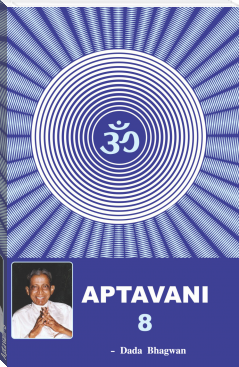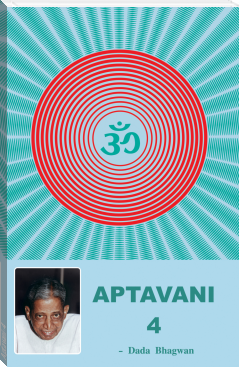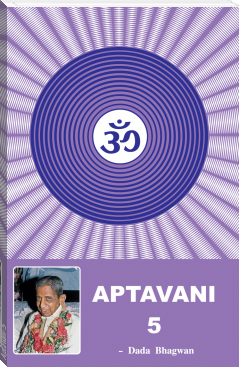Aptavani-8 by Dada Bhagwan (affordable ebook reader .txt) 📖

- Author: Dada Bhagwan
Book online «Aptavani-8 by Dada Bhagwan (affordable ebook reader .txt) 📖». Author Dada Bhagwan
The root cause of birth and death is ignorance (agnan). And with Gnan (knowledge of Atma), there is liberation; it is the ego that undergoes the cycle of birth and death. And birth in a place of creation (yoni) is dependent on scientific circumstantial evidence. There is no single independent entity in all this – not even God!
The false attribution (aropit bhaav),of ‘I am Chandubhai’ (reader to insert their own name here) together with theworldly intent(sansari bhaav), create the causal body (karan sharira), which in turn, initiate the coming together of other parliamentary members (the inner working component of the mind, intellect, chit and ego), to bring about a result that creates the effect body. After they arrive at a decision, the members leave. The decisions that are left behind; begin to formulate and come into effect one by one.
When the Atma leaves the physical body, even the subtle body or causal body, with its anger, pride, deceit and greed, also leaves with it. The causal body, in the next life, becomes the effective body. The electrical body (tejas sharira) is only there, as far as a balance of remaining karmas exists, that is to say, it is present throughout the entire avatar (lifetime). And it will stay with the Atma all the way until it attains the final liberation (moksha).
There can never be an independent power in the discharge (of karma), but even in the charging, the atma has no independent power. Because of the push from the discharging karma of the past, a new karma becomes charged, and this is all because of ignorance (agnanta). The charging of karma, in the previous lifetime, is in the form of an arranged plan, which in this lifetime takes shape in the form of discharge. Only in the planning stage (charging of karma) can any changes be made. Once it has taken shape, nothing can be altered. Any changes in this lifetime, will come to fruition in the next one, and if the planning itself comes to a halt, then one attains final liberation (moksha).
The theory of evolution has validity in the notion that a single-sensed organism (ekendriya) evolves into a human being. However, once the human condition is reached, the ego raises its head; becoming the doer, and goes on to do credit-debit of merit karma (punya) and demerit karma (paap). The tendencies (vruttis) incurred in human life, will determine the portal of entry into any one of the four life forms (bestial, human, demonic or divine). Upon attaining the human form, for eight lifetimes at the most, one wanders around from yoni (life-form) toyoni, paying off the balance of karma at each place, before returning to the human form. The end to the roaming can only happen after Atmagnan (Self-realization)! After Atmagnan, everything flows in an orderly sequence. If it did not happen in a systematic way, then would it not be considered as being in the hands of fate (niyati)? The timing for the living entity (jiva; self) to enter the human form for the very first time is predetermined. But because the ego arises in the human life-form, there are complications, and as a result, it wanders around in the four realms of existence (gati): human, animal, infernal and celestial. No matter how overwhelmed one is by the pressure of circumstances, if the ego can be steered in the direction of liberation (moksha), only then can moksha be attained. But to turn the ego, is not an easy feat; therefore, after taking birth in the human form, the timing for liberation (moksha) remains undetermined. Only after the enlightened or right Vision ( samyak drashti) arises, can the time for liberation be determined. But here, a person conducts himself according to relative worldly knowledge and societal influence (loksangnya), and is thrown into the flowing current of worldly life (sansar). Encountering a Gnani Purush, and acting in accordance to his knowledge, one can attain moksha.
In the circumstance (saiyog) of the sun, a shadow will be cast, and in the eventof a mirror, there will be a reflection. But how much doership does the sun or the mirror possess in this? From seeing the shadow or the reflection, simply the belief changes as to ‘What has happened to ‘me’?’ As a result of the established wrong belief, the ego and the intellect (buddhi) become established. And this is the reason why the mind-speech-body complex of the non-Self (prakruti) becomes bound. In reality, the original light illuminates the ego and the intellect,which subsequently begin to illumine the mind-speech-body complex. And so the Vision (drashti) towards, and the awareness of the original light vanishes; a curtain of illusion is drawn over the original light. And believing the mind-speech-body complex’s gestures to be one’s own, one relinquishes the seat of the Absolute Soul (Parmatma) and becomes and behaves as the body complex. It is like a sparrow that repeatedly pecks at its own reflection in the mirror, perceiving it to be another real sparrow. What an entrapment! How the Parmatma has been entrapped by the circumstances! In spite of it all, the Absolute Soul (Parmatma) has maintained its own true nature (swabhav), all throughout the three time periods (past, present and future).
Owing to the pressure of circumstances, a phase of the Atma’s property of knowledge has become contrary to its nature (vibhavik, unnatural). But not the real Atma (Self). In this unnatural (vibhavik) state, whatever the whim and imagination, the non-Self body complex (pudgal ) too became contrary to its nature (vibhavik),and as a result, the mind, speech and body were created, and they are bound by the rules of scientific circumstantial evidence (vyavasthit). And for that reason only, a person who comes into contact with the knower of this profound science – the Gnani Purush, can acquire the Vision of the Self through him, which leads him to the state of liberation. The story of Gajasukumar illustrates this: The father-in-law of Gajasukumar fixes a burning hot cauldron on Gajasukumar’s head (as he sat in meditation). At that moment, Gajasukumar was able to remain in the original light (as the Self) that Lord Neminath (Tirthankar), had shown him. Through the Gnan, he could see that event (saiyog) as the object to be known (gneya), and consequently he attained final liberation (moksha).
Because of the wrong belief of the Self’s identity and about doership; attachment-abhorrence (raag-dwesh) arises and consequently the three batteries of the mind, speech and body go on charging for the next life, and the three old batteries, according to their nature, carry on discharging. And when through the Gnani’s grace, the right belief is bestowed; one attains final liberation (moksha).
To eliminate doubt and uncertainty about the Atma’s inception or end, the Gnanis have called the Atma, anaadi-anant (without begin or end). If something is eternal, then how can it have a beginning or an end, increase or decrease? Wherein lies its origin? Where does a circle begin?
Without a beginning, how is something created? Besides, the creation and the creator are both destructible and transient.
Everything in the universe, functions according to its nature. And as a result, as many souls (jiva) on the path of evolution (samsaran marg) that enter Siddha kshetra (location for liberated Souls), that many will go from an undetermined state (avyavahar rashi), and enter the worldly state (vyavahar rashi), which preserves the integrity of the worldly life (vyavahar). If just one single soul (jiva) goes missing, Nature’s plan would come crashing down, so that today the moon, and tomorrow the sun, may be absent.
The increase and decrease of population cannot go beyond the constant of Nature’s law!
The Atma, by its very nature, is moving towards final liberation (moksha),as long as thereis no interference along the way. With auspicious (shubha) thoughts, the lighter subatomic particles (parmanu) are swept up, allowing the Atma to rise upward. Whereas, when the heavy and heavier subatomic particles are seized up, one plunges downwards, all the way into the plant life-form (vanaspatikay) – one enters into the form of a coconut tree, mango, or berry tree; bearing sweet fruit for people to eat; paying for one’s own deceit in the previous life, and becoming free from the debt karma.
Finally, after attaining awareness of the pure Soul (Shuddhatma) from the Gnani, and remaining in the awareness of the Self, while fulfilling all events related to the non-Self body complex (pudgal), it is possible to go to final liberation (moksha). Absolutely no one exerts any independent control over this scientific law!
The individual differences that appear in this world are because of illusion (bhranti), and because of assessment from the perspective of the intellect (buddhi). When seen through the Vision of the real element; from the center, there is oneness. That indeed is the Vision (darshan) of the Absolute Soul (Parmatma)!
The Gnani speaks after seeing it, as it is. He will not say, it is not, to it is, and he will not say it is, to when it is not. Pertaining to the properties (guna) of the eternal element, the detached Ones (Vitarags; Enlightened ones devoid of attachment and abhorrence) have described origin (utpaad), end (vyaya) and steadiness (dhrauv); wherein to originate and to end, are the phases of the element. And to remain in the steady-state, is the intrinsic quality (guna) of the element.
People have ascribed a gross and tangible (sthool) representation to these, by enshrining the symbolic effigies of Brahmaa (creator), Vishnu (preserver) and Mahesh (destroyer)! Oh! They have even placed the Gita and Gayatri in their shrines!
Instead of understanding the subtlest meaning about what Lord Krishna said in the BhagavadGita, they worship the physical idol. Instead of chanting the Gayatri mantra, they get more satisfaction from the statue. The scientific significance is forgotten altogether, and grossly misunderstood.
The statues of Brahmaa, Vishnu and Mahesh were installed as symbols to represent the three qualities (gunas) of, pious virtue (sattva), energy- filled worldly activities or passions (rajas), and darkness or sloth (tamas). Instead of getting lost in the alleys of metaphors about Truth, it is best to return home. The Gnani turns those who travel in the wrong direction, with great speed, in the right direction. He does this with the intent (bhaav) of being instrumental (a nimit) in the process and not with the intent of doership (karta bhaav). Truth can only be discovered through non-insistence (niragrahata). Insistence (aagraha) is ego. I am Chandubhai, I am his paternal uncle, I am her maternal uncle… etc. These relative truths prove to be non-truths in the real realm.
The Gnani always opens up the





Comments (0)